| item(s), Total: $0.00 View Cart |
| Shopping cart is empty. |
Hi There and welcome to our early Summer e-newsletter!
Apologies for the lateness of this newsletter - we have had an extremely busy couple of months over spring - lots has been happening and we've got loads being planned for 2012 - read on to find out what! We trust you've been enjoying some lovely Spring gardening, and that the lead up to Christmas for you is enjoyable and not too stressful. I would like to take this opportunity to thank you for your support over this past year, and wish you and yours a wonderful Christmas. So I hope you enjoy this newsletter - don’t forget, if you have anything you would like us to focus on in future editions, drop us a line.
Jobs for the garden this Summer By now I'm sure you're enjoying harvesting salads, a range of fresh herbs, and if you're lucky, or were organised enough to get them in early or over winter, you may even be enjoying your own home grown tomatoes! (Ours are only just forming.) In order to keep things going for as long as possible over our harsh summer, here are some things to consider:-
As of end October, 2011 we have been at the business now known as The Green Life Soil Co for a whole decade! Paul & Linda, together with Linda's brother Ray and sister in law Michelle, brought the Gaia Centre from Calen Feorne and Rebeka Newton-Creemers in 2001. We wanted to build on their range of organic gardening products and permaculture nursery. (The original Gaia Centre sign is still visible on the big shed, and serves as a reminder of our roots!) Intending to increase our range of nursery plants considerably, we renamed the business The Swan Garden Centre. It was nice having a lovely range of plants around, and we continued to do soils, composts and mulches together with the nursery. However, times changed and so did we... The soil side of the business continued to develop, with Paul starting to customise mixes for customers, depending on their base garden soils, what types of plants they were buying, and how they were going to be used. Then the large green box outlet opened in Midland. All over Perth, small independent nurseries suffered, and many who have survived have all specialised in their particular field of interest. Because of our change of direction, we decided to change our trading name early 2008 to more accurately reflect our core business, which was specialised soil mixes. Due to leasing arrangements we moved out of the big shed and into our current compact transportable office around this time. Also changes were made to the business structure, with Paul and Linda assuming full ownership of the business.
Our team has grown to include two full time staff, three part time staff and three casuals - all of which make a valuable contribution to our business. We have two (carbon neutral) delivery trucks on the road most days and deliver to our customers all over Perth. 2011 and Beyond Recently we launched an on-line shop branch of our business, which we hope will fill a need in the market for people wishing to purchase minerals, bagged product and some smaller items, without having to pay the usual delivery price which we need to charge with bulk loads (which are by necessity delivered on an individual basis). Around the same time we also launched a new and expanded website for Sand Remedy (www.sandremedy.com.au) - our Certified Organic mineral mix which replaces wetting agents. The website also has links for tutorial videos on how to use Sand Remedy, which we hope will be useful. This follows extra promotion we have done over spring with "Greenfingers" TV show. And earlier this year we entered the 2011 WA Environment Awards - and were thrilled to be selected as one of five finalists in the "Small Business - Leading By Example" category. The awards night was held recently at a swanky do at the Perth Convention and Exhibition Centre. The Painted Fish in Fremantle took out the prize; but we are still thrilled to have made it to the shortlist and to be up against such worthy competition. (And we'll have another go next year!!) We'll be back at the 2012 Garden Week next year in an exciting collaboration we are calling "Sustainability Square". I am co-ordinating some wonderful people with specialised knowledge to come and do talks on various aspects of gardening, permaculture and sustainable living (I'd love to hear from anyone willing to be involved!) so make sure you put Garden Week (19 - 23rd April) in your diary and come along! We would like to THANK YOU most sincerely for your support over the past decade. It has been an interesting journey for us, and we have been priviledged to have met so many wonderful customers over the years who are passionate about growing, sustainability, and making their own back yards and wider communities a better place for us all. We hope we are - and will continue - to help you grow a better garden - for yourself, for your family, and for the planet!
You Say To-mate-o I say tom-arto... (Let's bring the whole thing on!)
Judging will be in the form of a taste test, and will take place in early February. We will try to find a 'celebrity' judge - if we can manage to coerce someone.. But at the very least we will find someone independent (ie. not on staff or a family member!!). Of course, judging will be subjective and it's all meant in the spirit of fun and encouragement, so no correspondence will be entered into with disgruntled non-winners! We will probably have taste rankings, and if the entries warrant it, maybe special awards to things like "the biggest tomato", "the smallest tomato", "the most interestingly shaped tomato" - or any other category we think applies to a tomato worthy of special mention! So we hope you will give it a go - there will be prizes of gardening products, vouchers, bragging rights, and a certificate to show your grandchildren, neighbours, co-workers, mother-in-law, etc. Not to mention the fame of being featured in our next newsletter, and possibly the local newspaper (if it's a slow news week). Entry is open to individuals, families, community groups, etc, and any type of tomato variety. We embrace all types of Solanum lycopersicum, or even Lycopersicon lycopersicum or Lycopersicon esculentum (depending on which site you Google). What you need to do to enter & and other vague rules... 1. Grow some tasty tomatoes! It sounds obvious, but we HIGHLY recommend using our soil for the best results! Please grow them ORGANICALLY - keep the "icides" away - we're trusting you with this one! 2. Bring your tomato into our store by 4.00pm on Sunday, 5th February 2012, which is the closing time for the competition. When you bring in your entry, we will take your details, and each tomato will be given a number so that judging will be completely anonymous. 3. Once the judge(s) have completed their taste test, we will trace back and notify the grower/s, and arrange presentation of prizes/certificates. With their permission, we would like to follow up on winners gardening stories, and (if they're willing to share) get their top tips for tasty tomatoes to publish in the next newsletter! 4. Entry will be by gold coin donation. The Green Life Soil Co will match the total raised dollar-for-dollar, and donate all proceeds to charity. Which Charity? This may be something we allow our judge/s or maybe the overall winner to choose - we'll keep you posted on this but it will need to be a registered charity of course. 5. We reserve the right to make changes to these rules as we go along if we think up improvements. It's the first time we've run this contest, and we mean it to be a fun thing for everyone involved. So that's it - get growing - there's still time to get some tomatoes producing. We hope you will get inspired.
In case you're a novice gardener, but all inspired to give our taste contest a go, here are some interesting tomato facts and growing tips you may find useful. The latin name Lycopersicon esculentum translates to 'edible wolf peach'. Strange but true. They originated from South America and grow very well in many parts of the world with mild, temperate or tropical climates (depending on variety). And speaking of varities, there are hundreds of different varities available. If you want to blow your mind, check out the varieties available at www.edenseeds.com.au. Tomatoes are often categorised into 'Determinate' and 'Indeterminate' groups. Determinate tomatoes often (but not always) have a more bushy growth habit, and tend to require minimal staking. They often bear fruit all at once, which is handy if you wish to grow tomatoes for bottling or preserving.
Both varieties have their good points, and it may be a good idea to select a couple of each type to grow. To Stake or not to Stake Staking a tomato plant and keeping it tidy has the advantages of increased sunlight and airflow around the plant, making them less susceptible to some fungal type disease. It also makes working around the plants easier and accessing fruit to pick. However, it is certainly not essential. Allowing plants to sprawl has advantages too - namely fruit tends to be more protected from sunburn, and ripening is often a little more staggered. It can be either fun to play 'hunt the ripe tomato' or frustrating - depending on your point of view. To Prune or not to Prune Some gardeners swear that to grow the best tomatoes you must pinch out lateral growth to keep the vine strong and to get a greater crop. Others selectively prune foliage to allow greater sunlight and air circulation. Other gardeners don't bother trimming anything. Again - both methods work. Do what works for you. Peter Cundall is a staker, and a tip pincher-offer, so there you go. But I also bet his garden is very tidy and he never leaves his tools out in the rain. Just a guess. General Growing Tomatoes like a rich, improved soil and are hungry feeders. Don't over feed them nitrogen rich fertilisers (eg. chicken manure) as this encourages more leaf growth over fruiting. Use well rotted sheep and cow manures, and give them potash once a month to encourage flowering and fruit set. Do mulch plants over summer and ensure regular watering. If the soil is allowed to dry out, plants will stress and be more susceptible to problems. Pots or Garden? Tomatoes grow very well in pots or grow bags which are large enough (approx. 20 - 30L) so even small courtyard gardens can be productive! If you have had problems with any soil borne disease or nematodes, perhaps try growing in pots for a season or two. If you have limited space, cherry tomatoes are absolutely the most productive you can grow. Diseases Unfortunately tomatoes are susceptible to a number of pests and diseases, including:- Blossom End Rot Wilt Disease Ensure you keep insect pests under control to avoid spread of the disease. Fusarium wilt and Verticillium wilt are nasty soil borne viruses that can come from contaminated plants, seeds, stakes and gardening equipment. It can be very hard to eliminate once you have it in your garden. Strategies include crop rotation, using wilt resistant varieties, not saving seed from affected plants, and destroying (not composting) any infected plant material. In extreme cases growing in pots may be the only solution.
Nematodes Solarisation over summer also works - lay clear or black plastic over the soil and weigh down the edges. Leave for at least a month over the height of summer. Note that this has a detrimental effect on all soil micro-organisms! You will need to work to recolonise the soil with lots of healthy organic matter and fish hydrolysate when next preparing for planting. French and African marigolds grown in high numbers and left in the ground for at least two months also help with nematode control - they exude a natural chemical found to be toxic to nematodes. Plant them very thickly and enjoy their amazing colour while they do their work! Tomato Bugs/Shield Bugs Caterpillars/Budworm
Tomatoes benefit from having asparagus, basil, carrots, chives, mint, nasturtium, parsnip, onion, corn, borage, parsley, marigolds and celery as companion plants. In our last newsletter, we looked at the concept of Wicking Beds. They really do make great sense in our climate, and are a fantastic way to reduce the amount of water used in the garden. As a reminder, I have the link to the last newsletter and other wicking bed links listed below - it is worth having a look. Wicking beds can be large or small - and you can find many examples on the internet (and in our links) which show how to go about designing and making one. However, if you are pushed for time and DIY enthusiasm, remember that The Green Life Soil Co, in conjunction with Water Installations, has a wicking bed kit (including our Certified Organic Vegie mix and aggregate) now available. Please contact us for further information.
For further reading, and to see many more examples of wicking bed designs (including a video), here are some useful links: http://www.youtube.com/watch?v=WLsz5XWSE8o&feature=email Fruit Fly Control - Traps & Tips Fruit fly are an incredibly annoying pest - they can destroy a range of fruit and vegetable crops in a very short space of time. It is heartbreaking to be nurturing a fruit tree for years, sustained by the anticipation of your first juicy fruit only to have your dream shattered by a tiny, flying bug and its larvae. If you grow fruit, it is actually your resposibility to actively control fruit fly in your back yard. The Ag Department can enforce this, particularly if you are located near commercial growers. (As a child, I remember inspectors visiting in suburban Perth.) Unfortunately Fruit Fly are very difficult to control using purely organic methods; however you CAN help keep numbers down, and we will try and give you a few ideas which should help you enjoy the fruits of your labour (excuse the pun). Know Your Enemy
After mating, females will search for a suitable host in which to deposit her eggs. Soft fruit (such as apricots) are more preferable than harder fruits like apples and pears, but where populations are higher or there is a lack of preferred fruit, a much wider range of fruits can be infested. The Larvae (maggots) will hatch within 2 - 4 days. These little white grubs start out 1mm long but grow to about 8mm long, and are what most people recognise as fruit fly. Their activity causes fruit to rot and spoil. Once fully grown, the larvae leave the fruit, and burrow into the soil to pupate. The pupae resemble a small brown capsule about 4mm long. The pupation stage varies with temperature - it lasts around 2 weeks in summer, and can be about 7 weeks over winter. Eventually the adult emerges from the pupal case and burrows up through the soil. Here are the main methods to control Medfly:- Coversprays These are non-organic and I believe there are only three commercial insecticides registered for use in Western Australia. Unfortunately for economic reasons commercial fruit is sprayed routinely. While we always recommend organic gardening methods, in extreme cases we recognise it may be necessary to use pesticides. Hopefully once you have a servere outbreak under control, in future years you can practise less drastic control methods. ALWAYS read labels, follow instructions concerning withholding periods and NEVER use more than the recommended application rates. Foliage/Spot Sprays The spray is NOT applied to the fruit, but on the trunk or foliage of the tree. It is claimed that spraying on 1m2 area of foliage, or on a board which is then hung in the trees will control fruit fly for a 50m2 area. These sprays contain a fruit fly specific protein attractant, and an insecticide which will kill the fruit fly when it eats the protein. We stock Eco-Naturalure which is Certified Organic by BFA. Another product on the market is Yates Nature's Way Fruit Fly Control. Although not organic, it is claimed to be low toxic and also has no withholding period. Traps A number of different types of traps and baits are available for Medfly. Some are phermone based and will attract either males or females, depending on the product. Other baits or traps are based on a food source, and will attract both sexes, and possibly a number of other insects (both 'good' and 'bad') which will also die once captured. Traps can contain a bait and an insecticide, or they can be a simple 'wet' trap, where insects enter but then cannot find their way out, and will eventually drown in the solution. Traps are not considered to be hugely successful in controlling large numbers of Medfly, but they will certainly HELP, and can also help show the numbers of Medfly around, so if you DO choose to spray, you can do so at the most effective time. Commercial traps and baits are available to purchase (we have both available in stock); or you can very simply make your own; as per the diagram below. (The diagram shows a 2L bottle with handle - but any plastic bottle will do!)
1L hot water Dissolve the sugar and Vegemite in the hot water. Allow to cool before adding in remaining ingredients and mixing. Makes enough for approx. 3 - 5 traps. Use between 3 - 6 traps in and around each tree (hang amongst the foliage), and replace the baits every two weeks at least, or if they become full of flies, or the liquid evaporates too quickly. Baits which are too low or diluted with rain will be less effective. If you are using a non-toxic bait, you can dispose the trap contents into the chookpen - fowls are quite appreciative of the protein! Traps can also be placed in non-fruiting trees, and this can be an effective way to keep the flys away from your precious fruit too! Exclusion Bags and Netting Exclusion bags are available in a wide range of types and sizes locally from Guildford Town Garden Centre (9279 8645), and also on-line from Greenharvest. Completely organic, they prevent the adult fruitfly from getting to the fruit to lay her eggs - if used at the right time (again, you may find traps helpful as an indicator). Exclusion bags also prevent sunburn of fruit, and are re-useable. Netting trees with insect netting (on-line @ www.commercialnetmakers.com.au) or by using old net curtains is also effective, providing you can cover the tree to ground level. This method has the added benefit of keeping birds away from fruit, but is only practical where you have a small to medium tree that you can easily cover. The other way to use netting, or soft flywire, is to simply cover selected branches - think Christmas bon bons! Ensure you join all edges together well - you only need a tiny gap to allow the flies access. Good Housekeeping Simple, cheap - but why is it common to see fallen fruit left to rot at the base of a tree? This soft fruit is easily available for adults to lay eggs, and will allow numbers to expode. When picking up fruit that has been struck with Medfly, don't bury it or put it straight into the compost. The eggs and larve can survive. Freezing, cooking or pureeing the fruit will destroy the Medfly (and the fruit can then be fed to chooks). Soaking in water too will work, however the larvae can survive for a few days. It is recommended to add a thin layer of kerosene to the water, to seal the water and prevent the oxygen exchange. Alternatively put the fruit into a plastic bag (with no holes), tying it up securely, and leave it in the sun for a couple of weeks. The fruit will continue to break down, but it will also reach high temperatures which kill off the larvae. Check, and if no signs of life, the fruit can then be composted or disposed of. Finally, select varieties of fruit which are less susceptable to fruit fly - either through type of actual fruit or by when in the season it ripens. Often, early ripening varieties are less affected simply because Medfly numbers tend to build up as summer goes on. Alternatively if you move to a property that has a fruit tree you don't want, either arrange to give the fruit away or have someone harvest it for you (there are often people who will be happy to exchange a load of fruit for a supply of jam!); or perhaps remove the tree and replace it with something else (preferably also green and alive). That way you won't be contributing to fruit fly numbers in your area and you won't have the worry anymore. Using a combination of these methods will certainly help keep numbers of Medfly down, and you should be able to enjoy your own home grown fruit! Encourage your neighbours to do the right thing and control numbers too; otherwise all your hard work can be to no avail if your yard is continually being populated from over the fence! If they aren't keen gardeners, why not offer to make and check baits in their trees too - whilst being neighbourly it can also make a huge difference to your own harvest size! A little while ago now, a customer asked me whether I knew much about what flowers are edible. Apart from a few common ones, I wasn’t particularly able to help. So I decided I would like to do some research and present some information in the next newsletter. DISCLAIMER: I have based this piece on articles written by respected herb growers and gardeners, however PLEASE always do your own research and ensure positive plant ID before consuming ANYTHING. Some plants can be highly poisonous, and others can cause allergic reactions in people with sensitivities. As a very generalised rule, avoid plants with white milky sap. Always use common sense and consume small amounts of anything new. There have been some cases of toxic reaction to some flowers listed as edible, due to local sub-species having developed a toxic compound due to different soil or climatic conditions, or hybridisation. Be cautious, only try a small amount (one or two petals) first time around. Avoid flowers that are bitter or caustic. Remember that edible flowers are primarily used as a garnish - don't go making an entire salad from your flower garden. No responsibility or liability taken for allergic reactions, tummy aches - or worse - from consuming flowers listed in this article!!! So when in doubt, leave it out!! Herbs. All flowers of edible herbs are edible also. This includes basil, thyme, nasturtium, chamomile, edible sages (of which there are several varities). Of course whether they are too woody or hairy to be of culinary value is another question altogether!!
Elderberry flowers (Sambucus nigra) has long been used in wine, preserves etc. Lavender (English is best) – remove the individual tiny flowers from the core and sprinkle over icecream, or use in cakes and biscuits. Rosemary. Flowers can be used in casseroles or as a garnish. Use stems as BBQ skewers for a great looking and tasting kebab! Remove leaves and soak in water for a few minutes (so the stick is moist & won’t draw moisture from the meat). Pomegranate, quince, feijoa and stone fruit flowers are all edible. Use in dessert or as a garnish. Violas, Violets, Native Violets, Pansy and Heartsease all have edible flowers. They look exquisite used on top of cakes, or as a delicate dessert garnish. Carnations and Dianthus flowers are also edible. (I ate a carnation at a particularly memorable party in my early 20's and am still here to be ribbed about it.) Not personally sampled - but reportedly edible are Fuchsias, Hibiscus, Stocks, Gladioli, Dahlias, Camelia (Japonica), Cornflowers, Honeysuckle, Sunflowers, Petunias, Zinnia elegans, Tulips and Chrysanthemum flowers. Zucchini, pumpkin and squash flowers are all edible. Stuffed and fried zucchini flowers are a popular Italian treat. Sunjewels (Portulaca grandiflora) are also edible, as are flowers of Nymphaea sp. Water Lillies. Day Lily (Hemorocallis sp.) flowers and buds are edible - shred carefully and add to salads, a stir fry, or batter. Also their young roots can be used like carrots and eaten cooked or raw. (Please note however that many other plants with the common name 'lily' are highly poisonous.) Roses. Apparently at times in history the rose has been more highly prized for its edible hips than for the beauty of the flower itself. Particularly older varieties which – after the petals have fallen – leave a large swollen hip (the fruit); are prized for jam making. Rose 'flavours' vary just as do their perfumes. Petals can be added to desserts, jellies, and used in drinks. So there are a few ideas for you to try (once you've done your research)! Information for this piece was sourced from: If you have a friend or relative that loves their garden, don't forget we have gift vouchers available. Otherwise a gift of a couple of useful herbs (eg. parsley, chives, basil) potted up always looks lovely and is something useful that will last longer than a box of chocolates. Moon Planting calendars are now also in stock, and are a present that will last for the whole year! Something homemade is often appreciated - here is a simple recipe for a flower or herb vinegar that can be used in salads, etc: You will need:
Choose a pretty bottle, ensure it is clean and dry and gently insert edible flowers (eg. nasturtiums, borage, calendulas, or some perfect rose buds) if available, and/or some clean sprigs of herbs like thyme, oregano, lemon verbena, rosemary, sage, chives, orgegano, basil, etc. Store in a dark, cool place and shake carefully every couple of days. Note: some recipes advocate straining the original herbs from the vinegar before placing in a final bottle with fresh herbs for best presentation.
Until 31st January, as a special Thank You for being on our newsletter mailing list, we are giving you a special code which can be used on our on-line shop to receive a discount on our Fish Hydrolysate. This offer is also available in person - mention this offer (limit of one per customer) to receive the discount. Normal prices are: 1L bottle $12.00, 5L bottle $28.00, 20L drum $80.00 Newsletter discount is 20% off. For online shop, use Voucher Code 'Fishdyq'. Fish Hydrolysate is a concentrated form of fish emulsion, and makes a terrific liquid fertiliser and stimulates healthy microbial life in the soil. It is Certified Organic and is safe to use on all plants.
So until next time – have a great time this Summer in the garden! Have fun, and Let’s get dirty! (Don't forget - we'd love your feedback on this newsletter! Please contact us with your comments, or if you have any 'upcoming events' worthy of mention for the next newsletter - be warned publication date tends to be unreliable!) Thanks,
For costings, details of presenters, locations, etc., go to: www.permaculturewest.org.au Visit The Green Life Soil Co store or online shop for a range of garden products and organic garden supplies.
|



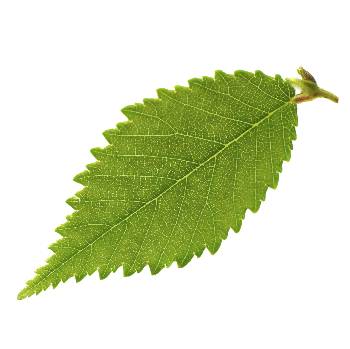 Hard to believe it but summer is here again!
Hard to believe it but summer is here again! In this newsletter:
In this newsletter: In 2008 we went down the track of organic certification and achieved this on a number of our more popular products.
In 2008 we went down the track of organic certification and achieved this on a number of our more popular products. We think it will work something like this...
We think it will work something like this... Indeterminate tomatoes are often more vine-like in growth habit and require staking or training. They tend to bear fruit over a longer period here and there, which is great for most home gardeners who like to have tomatoes on hand for salads over summer.
Indeterminate tomatoes are often more vine-like in growth habit and require staking or training. They tend to bear fruit over a longer period here and there, which is great for most home gardeners who like to have tomatoes on hand for salads over summer.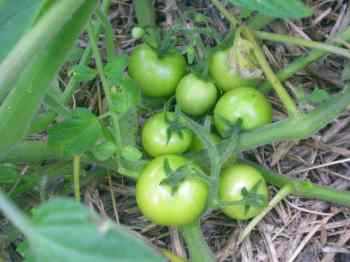 Sunburn
Sunburn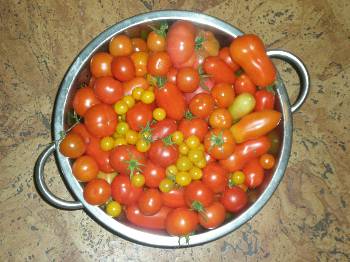 Companion Planting
Companion Planting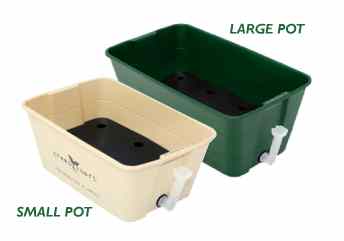 On a smaller scale, we now stock Greensmart plastic tubs, available in two sizes. These are great for small areas (like patios and verandahs) and are ideal for growing herbs just outside the kitchen door. These tubs work on exactly the same principle and are available with stands (to raise the working height) or wheels so they can be easily moved.
On a smaller scale, we now stock Greensmart plastic tubs, available in two sizes. These are great for small areas (like patios and verandahs) and are ideal for growing herbs just outside the kitchen door. These tubs work on exactly the same principle and are available with stands (to raise the working height) or wheels so they can be easily moved.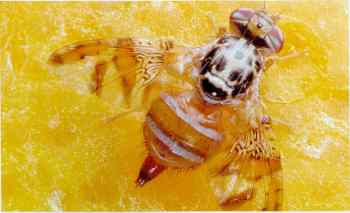 Queensland Fruit Fly were eradicated from Perth in the 1990's. The common Fruit Fly we get here in the west is the Mediterranean Fruit Fly (Medfly - see picture), thought to originate from tropical Africa, and was first detected in WA in Claremont in 1895.
Queensland Fruit Fly were eradicated from Perth in the 1990's. The common Fruit Fly we get here in the west is the Mediterranean Fruit Fly (Medfly - see picture), thought to originate from tropical Africa, and was first detected in WA in Claremont in 1895.  What you choose to use for bait is up to you. If you look on-line, there are a huge number of suggested recipes, many of which can be made from things you will already find in your cupboard. Here is one to try:
What you choose to use for bait is up to you. If you look on-line, there are a huge number of suggested recipes, many of which can be made from things you will already find in your cupboard. Here is one to try: Calendula (orange/yellow - see photo) and Borage (blue) are two of the more common edible flowers used. Flower petals look bright and colourful added to salads, or frozen in iceblocks and added to summer drinks. (Kids find this fascinating!)
Calendula (orange/yellow - see photo) and Borage (blue) are two of the more common edible flowers used. Flower petals look bright and colourful added to salads, or frozen in iceblocks and added to summer drinks. (Kids find this fascinating!)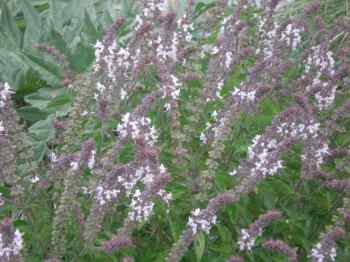 Bottle or bottles for finished product
Bottle or bottles for finished product




















